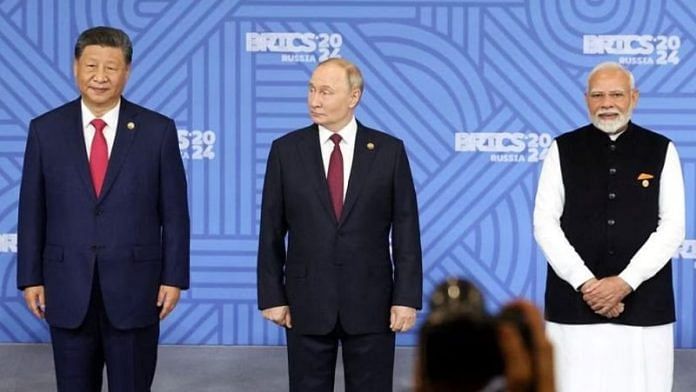The 16th BRICS Summit held in Kazan, Russia, attended by four new members, Egypt, Ethiopia, Iran and the UAE, besides the five founding members, and other invitees, would probably go down in history as the new Bretton Woods meeting. It was held in 1944 in New Hampshire, shortly before the end of the Second World War. Set apart by 80 years, the two historic meetings seem to have many parallels.
Some 44 war-ravaged allied countries inked the Bretton Woods Agreement to fix their rate of exchange to the US dollar, which could, in turn, be redeemed in gold. Unlike these allies, the US was largely unscathed by the war and could boast of a large gold reserve. The economic system and the world order that followed, supported by the US Dollar (USD) sowed the seeds of the International Bank for Reconstruction and Development (IBRD) and the International Monetary Fund (IMF).
The BRICS Summit in Kazan, attended by 40 countries, took place at a time when most of these economies face severe financial crises. Mainly, due to two major conflicts and several other minor ones, all being fought in the background of a worst pandemic that was more devastating than the Second World War.
Changing world order
Incidentally, the 1944 conference was attended by four of the five founding members of the BRICS, Brazil, Russia (then the Soviet Union), India and China. The two Communist entities and the leader of the Non-Aligned Movement (NAM), India, became part of the world order and the international financial institutions that followed the Bretton Woods Agreement. The same four countries with many other allies and supporters in the BRICS Summit are seeking to rewrite the rules of the emerging world order and bring about a revolutionary change in the global financial and trading order.
Attended by over 730 delegates, the Bretton Woods Agreement was facilitated by the United Nations Monetary and Financial Conference. It convened on 1 July 1944 and was presided over by the then US Treasury Secretary Henry Morgenthau Jr. and Lord John Maynard Keynes led the Commission II that dealt with the IBRD proposal. In the case of the “BRICS De-dollarisation Summit”, no leading globally acclaimed economist or a financial wizard was present. (The BRICS Academic Forum probably needs to do more homework on this aspect). Nevertheless, the political leaders who put their heads together at Kazan were representing major emerging economies that have survived wars and the pandemic, and are on the road to recovery, better and faster than the G7 and the Global North.
While the 1944 conference established IBRD and IMF, the BRICS already has the New Development Bank (formerly the “BRICS Development Bank”) since 2014. It has a seed fund of 100 billion USD and a reserve currency pool worth over another $100 billion. Yet, the seminal question that arises is whether the BRICS is biting more than it can chew.
Also read: Geopolitics has reached third inflexion point since WW II, Cold War. An opportunity for India
Can the USD be replaced?
Can any of the present currencies like the Euro, Yuan, Pound Sterling, Rupee, and Ruble or Crypto Currency replace the dollar? There is little doubt that the American economy is not in the pink of its health. The USD appears to be flexing its artificial muscles while internally it displays several features of a weak currency. Yet, the process of creating an alternative to global trade and reserve currency does not seem easy. And, it is probably too early to write the obituary of the USD. The Russia-China duo focussed on the agenda of providing an alternative currency model to end the supremacy of the American dollar, de-dollarisation, new trade policies, and the usage of local currencies at the 16th Summit of the BRICS. Given the geopolitical situation and sanctions imposed by the US on its adversaries, a new economic forum and a trade mechanism sans USD will be a game changer for the China-Russia-Iran axis.
Prime Minister Narendra Modi has strongly advocated for the use of local currency systems for cross-border trade settlements to overcome exchange rate volatility. India is aggressively promoting this besides allowing banks from about 22 countries to open Rupee Vostro Accounts (SRVAs) with Indian banks for cross-border trade settlements. Therefore, for New Delhi, a USD-free system is not an immediate priority nor an existential necessity to unconditionally support the China-Russia agenda of creating a de-dollarised global trade mechanism. New Delhi is very clear in its approach that the BRICS and its several verticals, as well as other regional forums and financial arrangements, are not anti-West but are part of larger trade-enabling measures.
Nevertheless, in the event of a quasi-regional, additional but not alternative, forum for USD-free trade and payment settlement mechanism to benefit the “non-West non-EU” economies, New Delhi should be part of it. Such a forum will widen the scope of India to conduct trade with countries that have a distinct geopolitical disadvantage in the emerging world order but are significant players in the multipolar order.
The author is the former editor of ‘Organiser’. He tweets @seshadrichari. Views are personal.
(Edited by Ratan Priya)






